第八讲课前准备:修辞与翻译
- 格式:docx
- 大小:18.50 KB
- 文档页数:2
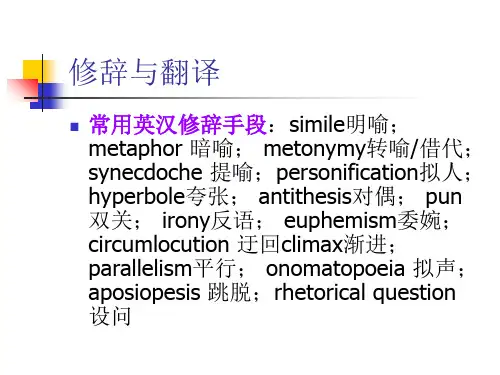
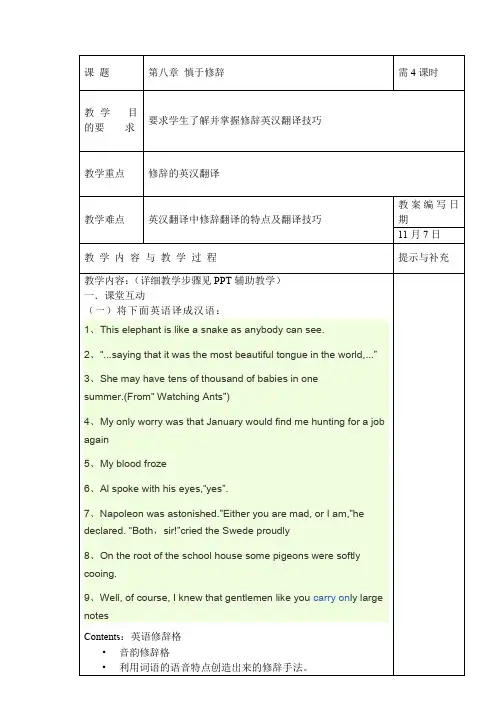
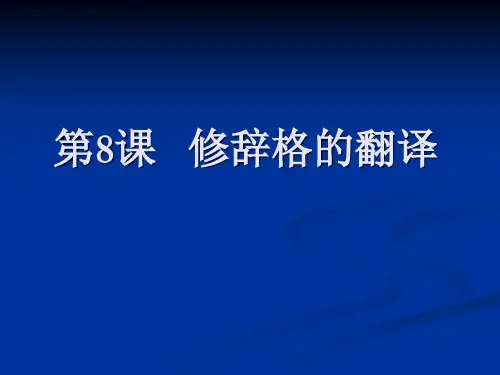
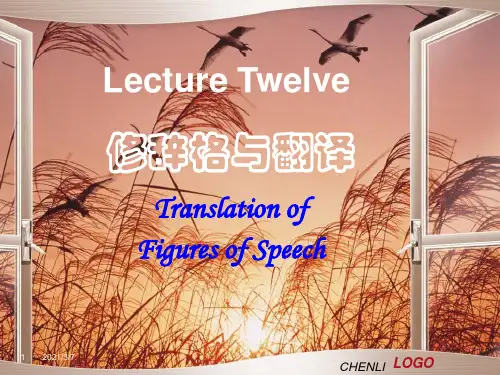
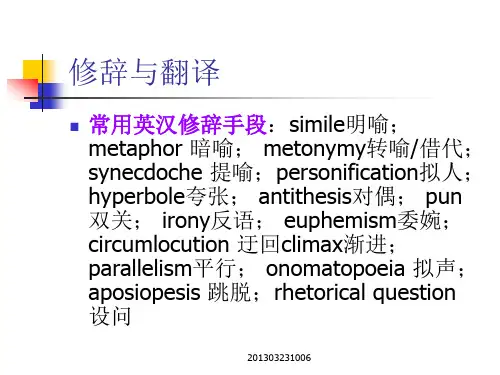
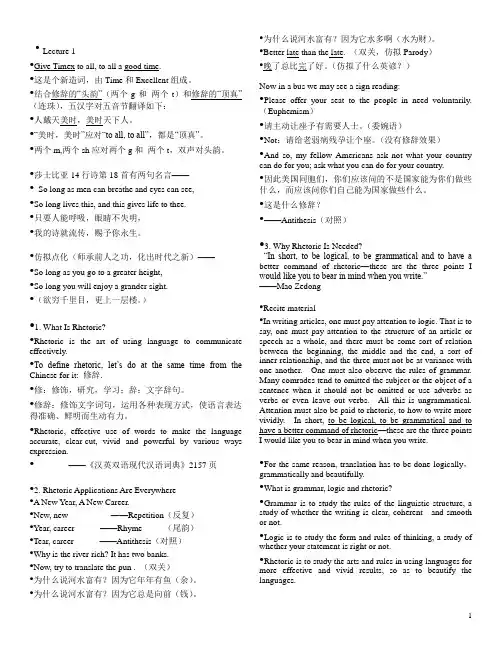
•Lecture 1•Give Timex to all, to all a good time.•这是个新造词,由Time和Excellent组成。
•结合修辞的―头韵‖(两个g和两个t)和修辞的―顶真‖(连珠),五汉字对五音节翻译如下:•人戴天美时,美时天下人。
•―美时,美时‖应对―to all, to all‖,都是―顶真‖。
•两个m,两个sh应对两个g和两个t,双声对头韵。
•莎士比亚14行诗第18首有两句名言——•So long as men can breathe and eyes can see,•So long lives this, and this gives life to thee.•只要人能呼吸,眼睛不失明,•我的诗就流传,赐予你永生。
•仿拟点化(师承前人之功,化出时代之新)——•So long as you go to a greater height,•So long you will enjoy a grander sight.•(欲穷千里目,更上一层楼。
)•1. What Is Rhetoric?•Rhetoric is the art of using language to communicate effectively.•To define rhetoric, let‘s do at the same time from the Chinese for it: 修辞.•修:修饰,研究,学习;辞:文字辞句。
•修辞:修饰文字词句,运用各种表现方式,使语言表达得准确、鲜明而生动有力。
•Rhetoric, effective use of words to make the language accurate, clear-cut, vivid and powerful by various ways expression.•——《汉英双语现代汉语词典》2157页•2. Rhetoric Applications Are Everywhere•A New Year, A New Career.•New, new ——Repetition(反复)•Year, career ——Rhyme (尾韵)•Tear, career ——Antithesis(对照)•Why is the river rich? It has two banks.•Now, try to translate the pun . (双关)•为什么说河水富有?因为它年年有鱼(余)。

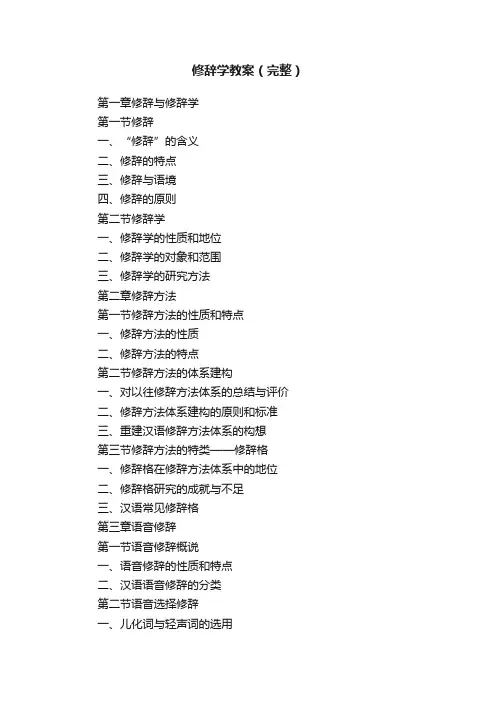
修辞学教案(完整)第一章修辞与修辞学第一节修辞一、“修辞”的含义二、修辞的特点三、修辞与语境四、修辞的原则第二节修辞学一、修辞学的性质和地位二、修辞学的对象和范围三、修辞学的研究方法第二章修辞方法第一节修辞方法的性质和特点一、修辞方法的性质二、修辞方法的特点第二节修辞方法的体系建构一、对以往修辞方法体系的总结与评价二、修辞方法体系建构的原则和标准三、重建汉语修辞方法体系的构想第三节修辞方法的特类——修辞格一、修辞格在修辞方法体系中的地位二、修辞格研究的成就与不足三、汉语常见修辞格第三章语音修辞第一节语音修辞概说一、语音修辞的性质和特点二、汉语语音修辞的分类第二节语音选择修辞一、儿化词与轻声词的选用二、响音字与衬音字的选用三、双声、叠韵、叠音形式的选用第三节语音配合修辞(停延、节奏、轻重、抑扬等)一、声韵调的协调与呼应二、音节的协调与呼应三、音组的协调与呼应第四节谐音修辞一、谐音双关二、谐音歧义三、谐音转义四、谐音假对五、谐音仿拟第五节拟音修辞一、拟声词其实是一种修辞词类二、汉语常见拟音修辞方法第四章语义修辞第一节语义修辞概说一、语义修辞的性质和特点二、汉语语义修辞的分类第二节同义修辞和反义修辞一、同义修辞二、反义修辞第三节上下义修辞和类义修辞一、上下义修辞二、类义修辞第四节多义修辞和单义修辞一、单义修辞二、多义修辞三、模糊修辞第五章语法修辞第一节语法修辞概说一、语法修辞的性质和特点二、汉语语法修辞的分类第二节词法修辞一、词类选择修辞二、词类活用修辞第三节句法修辞一、句法选择修辞二、句法配合修辞第四节篇法修辞一、形合谋篇与修辞二、意合谋篇与修辞第六章语形修辞第一节语形修辞概说一、语形修辞的性质和特点二、汉语语形修辞的分类第二节书面语形修辞一、汉字修辞二、非文字图符修辞第三节口语语形修辞一、态势语与修辞二、非语词声音与修辞三、伴随性因素与修辞第七章风格与修辞第一节言语风格与修辞一、言语风格的性质和分类二、言语风格的成因与修辞第二节语体风格与修辞一、语体的性质和分类二、语体修辞第八章汉语修辞学简史第一节汉语修辞学史及其研究概况一、修辞学史的性质二、汉语修辞学史的研究现状第二节汉语古代修辞学史说略一、汉语古代修辞学的演变轨迹二、汉语古代修辞学的演变规律第三节汉语现代修辞学史说略一、汉语现代修辞学的发展脉络二、汉语现代修辞学的发展规律第一章修辞第一节“修辞”的含义(一)修辞的三种含义1、语言运用活动(修辞行为)2、语言策略和技巧(修辞方法)3、研究语言运用规律的一门学科(修辞学)(二)“修辞”溯源1、出处目前所见最早的修、辞连用:“子曰:君子进德修业。

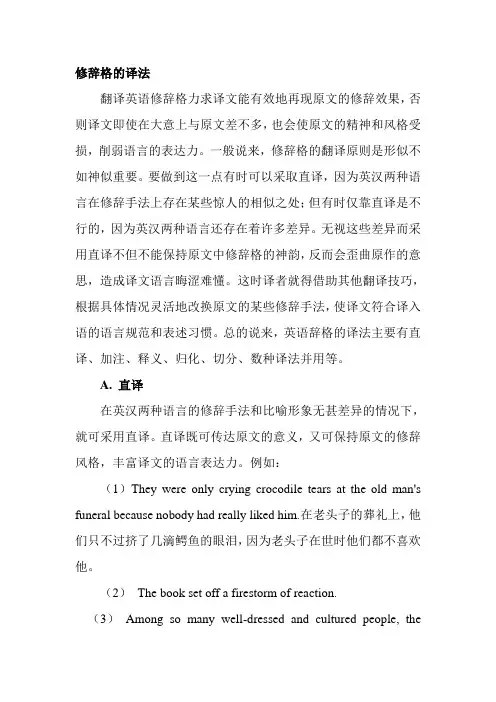
修辞格的译法翻译英语修辞格力求译文能有效地再现原文的修辞效果,否则译文即使在大意上与原文差不多,也会使原文的精神和风格受损,削弱语言的表达力。
一般说来,修辞格的翻译原则是形似不如神似重要。
要做到这一点有时可以采取直译,因为英汉两种语言在修辞手法上存在某些惊人的相似之处;但有时仅靠直译是不行的,因为英汉两种语言还存在着许多差异。
无视这些差异而采用直译不但不能保持原文中修辞格的神韵,反而会歪曲原作的意思,造成译文语言晦涩难懂。
这时译者就得借助其他翻译技巧,根据具体情况灵活地改换原文的某些修辞手法,使译文符合译入语的语言规范和表述习惯。
总的说来,英语辞格的译法主要有直译、加注、释义、归化、切分、数种译法并用等。
A. 直译在英汉两种语言的修辞手法和比喻形象无甚差异的情况下,就可采用直译。
直译既可传达原文的意义,又可保持原文的修辞风格,丰富译文的语言表达力。
例如:(1)They were only crying crocodile tears at the old man's funeral because nobody had really liked him.在老头子的葬礼上,他们只不过挤了几滴鳄鱼的眼泪,因为老头子在世时他们都不喜欢他。
(2)The book set off a firestorm of reaction.(3)Among so many well-dressed and cultured people, thecountry girl felt like a fish out of water.(4)I would my horse had the speed of your tongue(5)I deserve neither such praise nor such censure.(6)On the 14th of March, at a quarter to three in the afternoon, the greatest living thinker ceased to think.B. 加注加注也是丰富译入语语言表达法的一种有效方法。

修辞语翻译课程3拟人PERSONIFICATION1. 定义拟人辞格顾名思义就是把物拟成人。
Webster’s New World Dictionary定义personification为: “a figure of speech in which a thing, quality, or idea is represented as a person. 在修辞学上,拟人法是指把非人的东西(如动物、植物、物体、抽象概念等)当作人来描写,并赋予它们以人的特性、外表及活动方式等。
在拟人法中,把那些只适用于描写人的动词、形容词、名词、人称代词等用来描写非人的东西,使之具有人的属性。
在寓言、童话、谚语、诗歌等文体中,拟人法常用来抒发感情,增强文章的感染力。
2.表达方式1)把自然现象或物拟人化The current lingers along gently. It comes flowing softly through the midmost privacy and deepest heart of a wood which whispers it to be quiet; while the stream whispers back again from its sedgy borders, as if the river and wood were hushing one another to sleep. 河水轻轻地游荡。
它从密林最深处无人知晓的地方静悄悄流出,树木对它低声耳语,叫它静一点;溪流从芦苇边界也低声回话,好像小河溪和树木在彼此催促入睡。
*文中把河溪和树木等自然现象拟人化了,写得生动形象,富有情趣,似乎把人带进了仙境。
The rain to the wind said“You push and I’ll pelt,”They so smote the garden bedThat the flowers actually kneltAnd lay lodged—though not deadI know how the flowers felt.( Robert Frost )雨对风说:“你来狂吹,我来猛落。
第八章辞格分析[教学目的:从理论上具备判断辞格的基本能力;描写常用辞格的结构特征和表达价值][教学要求:要求学生能在实际语言活动中辨别辞格并解释其作用,并能在此基础上运用理论知识构造新例,丰富表达手段,提高表达水平;掌握相似辞格的辨别角度与方法]第一节辞格的定义与确立依据一、辞格的定义与分类在言语行为中,人们常常不满足于常规的词语组合、句子构造等语言规则和表达原则,而是在符合语言表达常规的基础上,运用一些在词语、句子组合及语义实现上有所“违规”的表达手段,来取得特定的修辞效果,这种在言语行为中对语言规则等进行有效偏离形成的具有特定表达价值的固定模式,就是辞格。
从形式上看,辞格是有两个部分构成的,一个是辞格得以传载的表层结构体,可以将它称作辞面;另一个部分是通过辞面所指称的对象(如借代、借喻等)或能实现的修辞功能或深层意义(如反语、双关、排比)等,可以将它称为辞里。
如:(1)一间阴暗的小屋子里,上面坐着两位老爷,一东一西。
东边的是一个马褂,西边的是一个西装。
(鲁迅《写于深夜》)其辞面就是“马褂”、“西装”,其辞里就是它们分别指代的两个人:穿马褂的人、穿西装的人。
有的辞面与辞里的关系较为直接,如借代、比拟、明喻、暗喻等;有的辞面与辞里的关系就很隐晦,如借喻、反语、双关等。
从辞格的形成特点看,有的辞格是在词、句组合以及语义表达上故意偏离一般语言规则构造的,其目的是强调语义内容的超常表达。
这类辞格没有特别明显的辞面识别标志。
如比拟,本体与拟词的搭配就偏离了一般词语组合规则,实现了语义的超常组合;又如反语,表达意义与原义恰好相反等等。
此类辞格还有:比喻、移就、夸张、双关、拈连、易色、借代等。
有的辞格则主要是在语义表达的具体形式上刻意求美而故意偏离一般语用原则构造的,其目的是在不违反一般词、句组合等语言规则的前提下达到强调超常形式表达的效果。
这类辞格在结构形式上有明显的辞面识别标志。
如对偶、排比、顶真、回环、反复等就属这样的辞格。
第⼋讲课前准备:修辞与翻译6. 修辞与翻译⼀、了解下列修辞格⾳韵修辞格(Phonetic Stylistic Devices)alliteration, onomatopoeia,assonance, rhyme语义修辞格(Lexical Stylistic Devices)simile, metaphor, metonymy, personification, irony, hyperbole, understatement, allusion, euphemism, contrast, oxymoron, transferred epithet, pun, zeugma, parody, paradox结构修辞格(Syntactical Stylistic Devices)repetition, chiasmus, parallelism, antithesis, rhetoric question, anastrophe,anticlimax⼆、修辞格的判断1. Beware of the bottle.2. He had seven mouths to feed in his family.3. This diligent student seldom reads more than an hour per month.4. The candidate met his Waterloo in the national elections.5. I didn’t half like that.6. My only love sprung from my only hateToo early seen unknown, and known too late!----- Romeo and Juliet7. Make a way out of no way.8. an audible stillnessbitter sweet relationpainful pleasurean honorable villain9. Never show the bottom of your purse or your mind.10. Never let a fool kiss you or a kiss fool you.11. He sprung to his feet, flung off his coat, drew his sword, jumped upon theenemy, and burped.三、修辞格的翻译A.直译:1、Among so many well-dressed and cultured people, the country girl felt like a fishout of water.2、I would my horse had the speed of your tongue.3、薛蟠也假说来上学,不过是“三天打鱼,两天晒⽹”……却不曾有⼀点⼉进益。
6. 修辞与翻译
一、了解下列修辞格
音韵修辞格(Phonetic Stylistic Devices)
alliteration, onomatopoeia,assonance, rhyme
语义修辞格(Lexical Stylistic Devices)
simile, metaphor, metonymy, personification, irony, hyperbole, understatement, allusion, euphemism, contrast, oxymoron, transferred epithet, pun, zeugma, parody, paradox
结构修辞格(Syntactical Stylistic Devices)
repetition, chiasmus, parallelism, antithesis, rhetoric question, anastrophe,anticlimax
二、修辞格的判断
1. Beware of the bottle.
2. He had seven mouths to feed in his family.
3. This diligent student seldom reads more than an hour per month.
4. The candidate met his Waterloo in the national elections.
5. I didn’t half like that.
6. My only love sprung from my only hate
Too early seen unknown, and known too late!
----- Romeo and Juliet
7. Make a way out of no way.
8. an audible stillness
bitter sweet relation
painful pleasure
an honorable villain
9. Never show the bottom of your purse or your mind.
10. Never let a fool kiss you or a kiss fool you.
11. He sprung to his feet, flung off his coat, drew his sword, jumped upon the
enemy, and burped.
三、修辞格的翻译
A.直译:
1、Among so many well-dressed and cultured people, the country girl felt like a fish
out of water.
2、I would my horse had the speed of your tongue.
3、薛蟠也假说来上学,不过是“三天打鱼,两天晒网”……却不曾有一点儿进益。
4、假作真时真亦假,无为有处有还无。
5、“娘,他们……是要剥我们中国人的脸皮啊,你知道吗?”/ 骄阳下,柳树上,回答他
的是一片“知了,知了”的蝉声。
B.直译加注:
1、--- Why are parliamentary reports called "Blue Books"?
-- Because they are never red.
C.意译:
C1. 舍弃修辞格
1、You want your pound of flesh, don't you?
2、I spoke to them in hesitant English.
3、He is the mouth of the House in its relations with the Crown.
4、我半世的辛苦,全是替他们做马牛!
C2. 替换原修辞格
1、He was so fond of talking that his comrades nicknamed him “magpie”.
2、It is regrettable that our appeal remained a dead letter.
3、他看见别人生活比自己好,就犯红眼病。
4、Up and down he walked, up and down across the library floor.
5、层层的叶子中间,零星地点缀着些白花,有袅娜地开着的,有羞涩地打着朵
的;正如一粒粒的明珠,又如碧天里的星星。
6、From their slopes flow streams feeding the oases strung along the rim of inland
deserts.
7、She lost her heart and necklace at a ball.
8、Franklin Roosevelt listened with bright-eyed smiling attention.
C3. 增添修辞格
1、He determined to satisfy himself of the real state of the case.
2、I judge that there was going to be a crash by and by, but I was in now and must
swim across or drown.。